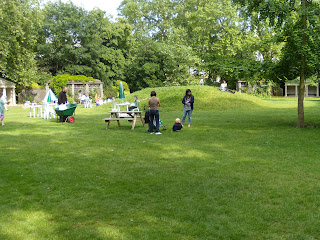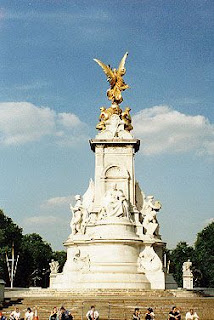Victoria here, continuing with a report on our Sunday, June 13, as we tried to get to as many open square gardens as we could. We made a small detour on our trek from Markham Square to the next garden on our agenda in Belgravia. While we were walking up King’s Road in Chelsea, we came across a Jo Malone shop. Kristine is a devotee of their products and I had my introduction, so we had a brief shopping opportunity sandwiched among our gardens. I was amused by their shades with similar arrangements to their windows.

Properly lotioned and perfumed, we walked on to Eaton Square, that fabled location of Upstairs, Downstairs, exteriors filmed at 65 Eaton Place, appearing as 165 Eaton Place (which does not exist). The houses of Belgravia are beautiful, and almost entirely of this same or similar design of white stucco with balconies outside the principle floor. The neighborhood was developed on property owned by the Grosvenor family (Dukes of Westminster) in the 1820’s. It remains a posh district, though most of the houses are either embassies, offices and/or apartments. I could settle for one of the apartments, I think.
Here is the description from the Open Squares Weekend booklet: “Eaton Square is one of London’s premier addresses. Together with Belgrave Square, layout was started in 1826 by Thomas Cubitt (1788–1855) for the Grosvenor Estate. The gardens were named after Eaton Hall in Cheshire, home of the landowners, the Dukes of Westminster.”

One of the six separate squares was welcoming guests and we found it charming and beautifully appointed.
Planters, pools, lawns, many trees and flower borders all add to the comfortable effect.
I love contrasts, such as these plants show. Of course I don’t know their names, but the yellow-green against the orange and dark green is perfect.

Here a bower of clematis vines shade a bench. Perfect for an afternoon settling in with a good book. I would include a couple of pillows in my kit.

Would it be an English garden without roses? I particularly like these blush-tone beauties — again a perfect contrast to the dark greenery.

They had a Punch and Judy show for the special weekend visitors.

These children were more interested in photographing flowers and insects, though the butterflies seemed preoccupied.
The tree above is usually called a Plane Tree. You find these all over London (and many other European cities) because they seem to thrive on the polluted air in urban areas. In fact, one gardener told me that they had done even better when the air was filled with coal dust in the early 20th C. Plane trees are closely related to the North American Sycamore, aka Buttonwood.
Above, more views of Eaton Square.
Our next stop was Cadogan Place Gardens, again named after a prominent family in 18th C. London.
Here is the description: At the end of the 18th century this garden was originally known as the London Botanic Garden.
 The severe storm in 1987 resulted in the loss of many large trees, which have now been replaced with a variety of ornamental trees, opening up the garden. The 300-year-old mulberry trees on the south lawn are thought to have been grown for the silk trade; an interesting mixed border is planted opposite the mulberries. On the east side, a walk running the length of the garden is being developed for spring interest, along with a fern garden.
The severe storm in 1987 resulted in the loss of many large trees, which have now been replaced with a variety of ornamental trees, opening up the garden. The 300-year-old mulberry trees on the south lawn are thought to have been grown for the silk trade; an interesting mixed border is planted opposite the mulberries. On the east side, a walk running the length of the garden is being developed for spring interest, along with a fern garden. Near the tennis courts, a water garden is partially hidden by black bamboo and willows, while the centre south garden displays the Hans Sloane Garden, created for the 2005 Chelsea Flower Show. William Wilberforce (1759-1833), campaigner for the abolition of slavery lived at 44 Cadogan Place.
Near the tennis courts, a water garden is partially hidden by black bamboo and willows, while the centre south garden displays the Hans Sloane Garden, created for the 2005 Chelsea Flower Show. William Wilberforce (1759-1833), campaigner for the abolition of slavery lived at 44 Cadogan Place.
A few flowers in Cadogan Gardens, above and right. The Cadogan name is pronounced, according to the official taking our tickets: Kuh-DUG-un.

Our next stop, and let me tell you, we were dragging by this time, was Belgrave Square, also part of the Grosvenor estate development of the 1820’s. Here is the description:
A 4.5-acre private garden designed by George Basevi, first planted by Thomas Cubitt in 1826 and now restored to its 1867 layout. The latest element in this work has been the re-instatement in 2008 of the original viewing mound in the centre of the garden.
 There are many trees, including large plane trees dating from the original plantings, and pergolas covered with wisteria and roses. The square also features a quiet garden, a play area for children and a tennis court.
There are many trees, including large plane trees dating from the original plantings, and pergolas covered with wisteria and roses. The square also features a quiet garden, a play area for children and a tennis court.
The statuary around the garden reflects the international nature of the square and offers a rare chance to see a collection of modern figurative work. A 1998 statue of Sir Robert Grosvenor by Jonathan Wylder at the corner of Wilton Crescent features the quote from John Ruskin: ‘When we build, let us think we build for ever’.
 The Belgrave Square garden committee seeks to balance the maintenance of the garden’s historic character with the needs and expectations of modern users and the preservation of the square for the future. The result is a garden which offers peace and tranquillity in a busy city and also provides a fun play space for local children
The Belgrave Square garden committee seeks to balance the maintenance of the garden’s historic character with the needs and expectations of modern users and the preservation of the square for the future. The result is a garden which offers peace and tranquillity in a busy city and also provides a fun play space for local children.

By this time, I was yearning for a bench to rest my weary — well, which were in worse shape? My aching feet? My tired legs? Or my poor back? And it was almost five o’clock when the gardens would be locked up again. So we staggered into Wilton Crescent and flopped down on the nearest bench.

Wilton Crescent is surrounded by more of tho
se stately white stucco houses. If you look closely at the photo, you will see one of the metal sculptures of a tree that decorate the garden.
Here is the description: Wilton Crescent was an addition by Thomas Cundy, the Grosvenor Estate surveyor, to the original 1821 Wyatt plan for Belgravia. The garden was highly commended in the 2009 London Gardens Society Competition.

Right is another of the sculptured trees which make a dramatic contrast to the green shrubbery and must be quite pretty in winter too. We liked the neighborhood. And it was just a very short walk to our next adventure.
Here is the doorway of one of the houses we picked out as our possible pied-a-terre in London. But on second thought, that topiary on the left is a little crooked. Guess I’ll have to keep looking. But I’ll stay in this neighborhood so my local pub will be….
The Grenadier! Yes, our long and winding road through London gardens brought us through this little mews to the pub and the comfort of a nice chair and a cool brew. We were a bit early for our meeting with
Carrie Bebris and her dad Jerry, so we sat around and talked to other patrons. Kristine got a chance to practice her French accents with a pair of travelers from Switzerland.

The sentry box seems to be only a storage shed, decorative as it is. It was too light to look for the ghosts. As if we had the energy left to find them! They never did make an appearance that evening, probably realizing we would only ask them for foot massages and back rubs.

Carrie and Vicky shared a hug in one of the two tiny dining rooms. Carrie and her dad Jerry were finishing up her research trip to Lyme Regis, Bath and environs with a couple of days in London. Carrie, author of the Mr. and Mrs. Darcy mystery series, is working on her next novel in which the Darcys will meet up with Captain and Mrs. Wentworth, of
Persuasion fame.
Above, Carrie Bebris and her dad Jerry Morris

We were lucky to s
ecure a table since The Grenadier was packed. Not that it takes very many people to fill its two tiny dining rooms and taproom. We all four enjoyed the Sunday Roast dinner — beef with potatoes, bed and Yorkshire pudding. Yum!
Since the Grenadier is located quite close to the barracks where some of the Duke of Wellington’s troops were housed, it used to be filled with redcoats…but nary a one was there Sunday night. Above is the mounting block used by the Duke of Wellington after his visits to The Grenadier.

After dinner, we searched for the ghosts, but they eluded us.

There were lots of pretty flowers. But no ghosts.
We said good-by at the tube stop at Hyde Park Corner. Yes, that is Apsley House in the distance at the far right. Carrie and Jerry had tickets for a play at the Globe theatre the next night. Kristine and I had a day of shopping planned.
And lots more walking!
Also in our Marylebone neighborhood is Durants Hotel which traces its origin back to the 18th century. However, there was also a Durant’s Hotel in St. James’ Jermyn Street, which may have been the more famous of the locations in the Regency and early Victorian periods. Nevertheless, we’d love to stay here in its old English Men’s Club-designed setting.




